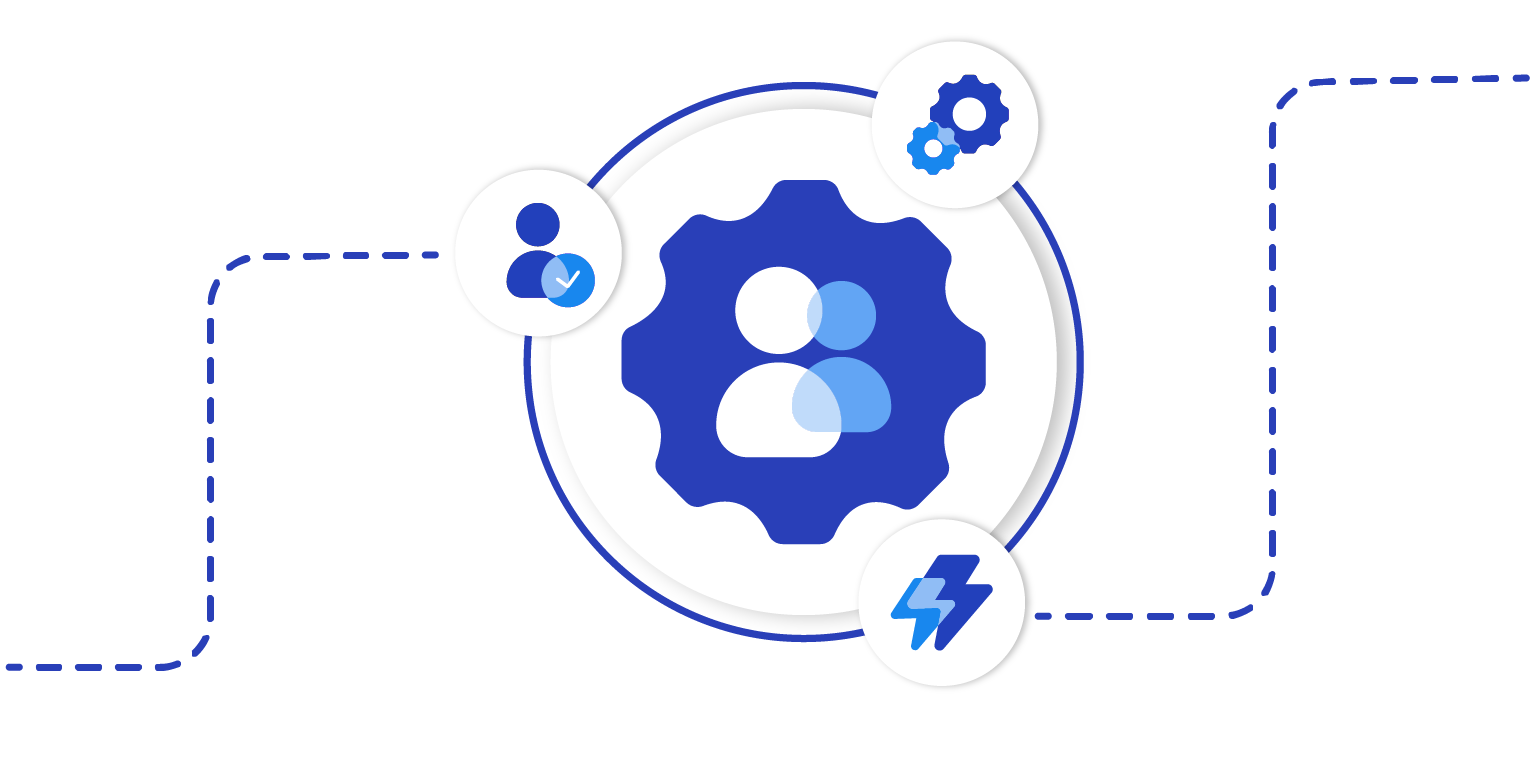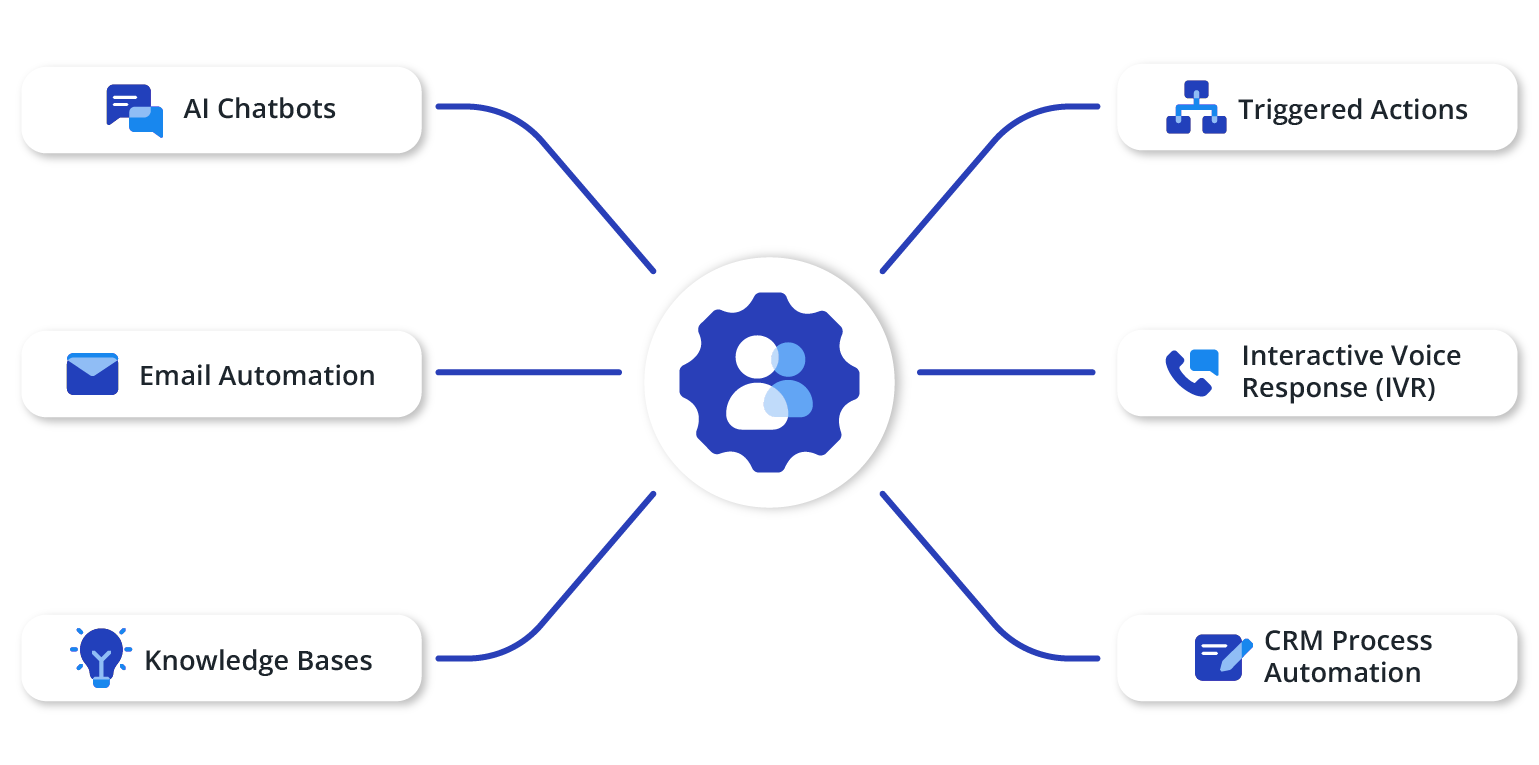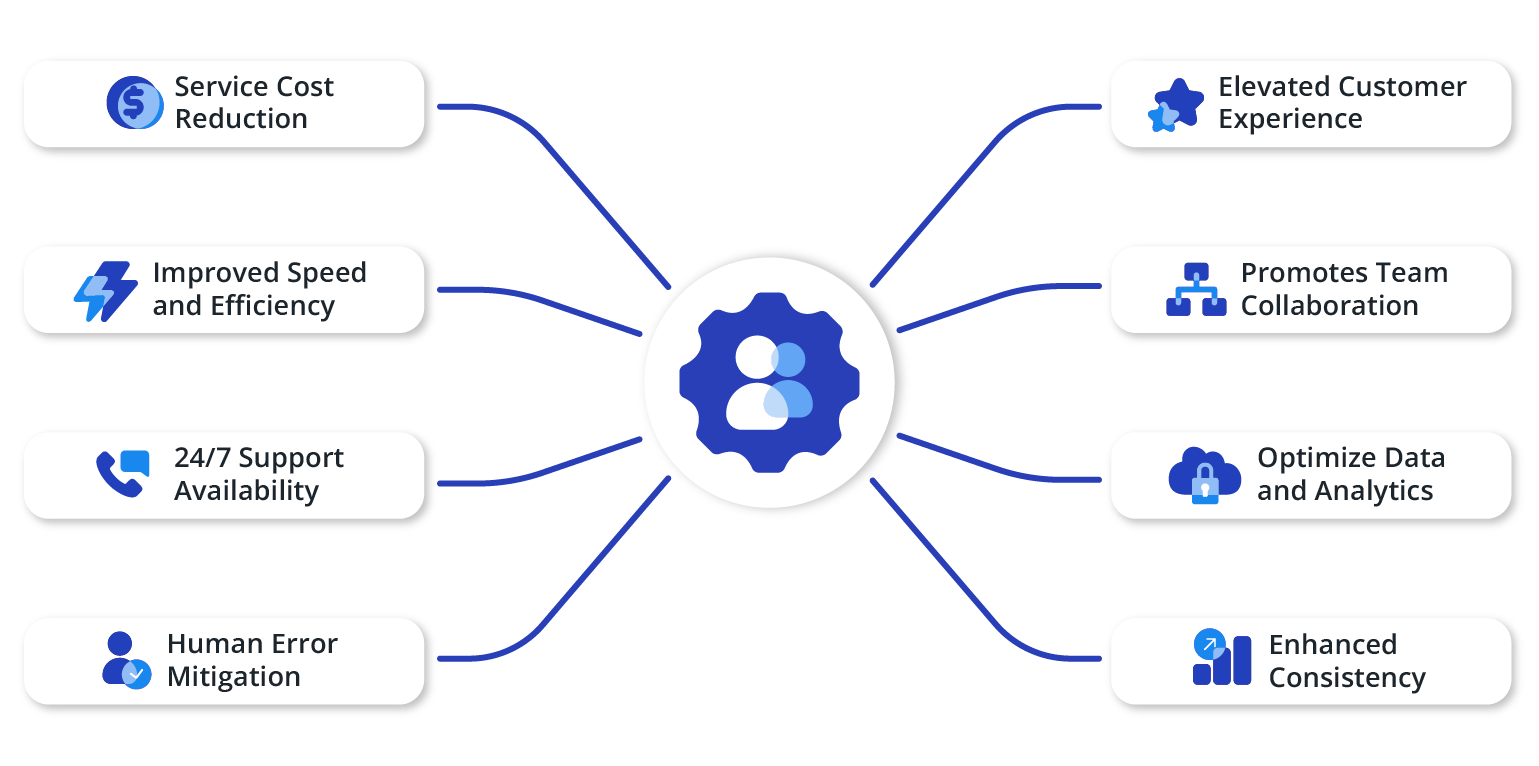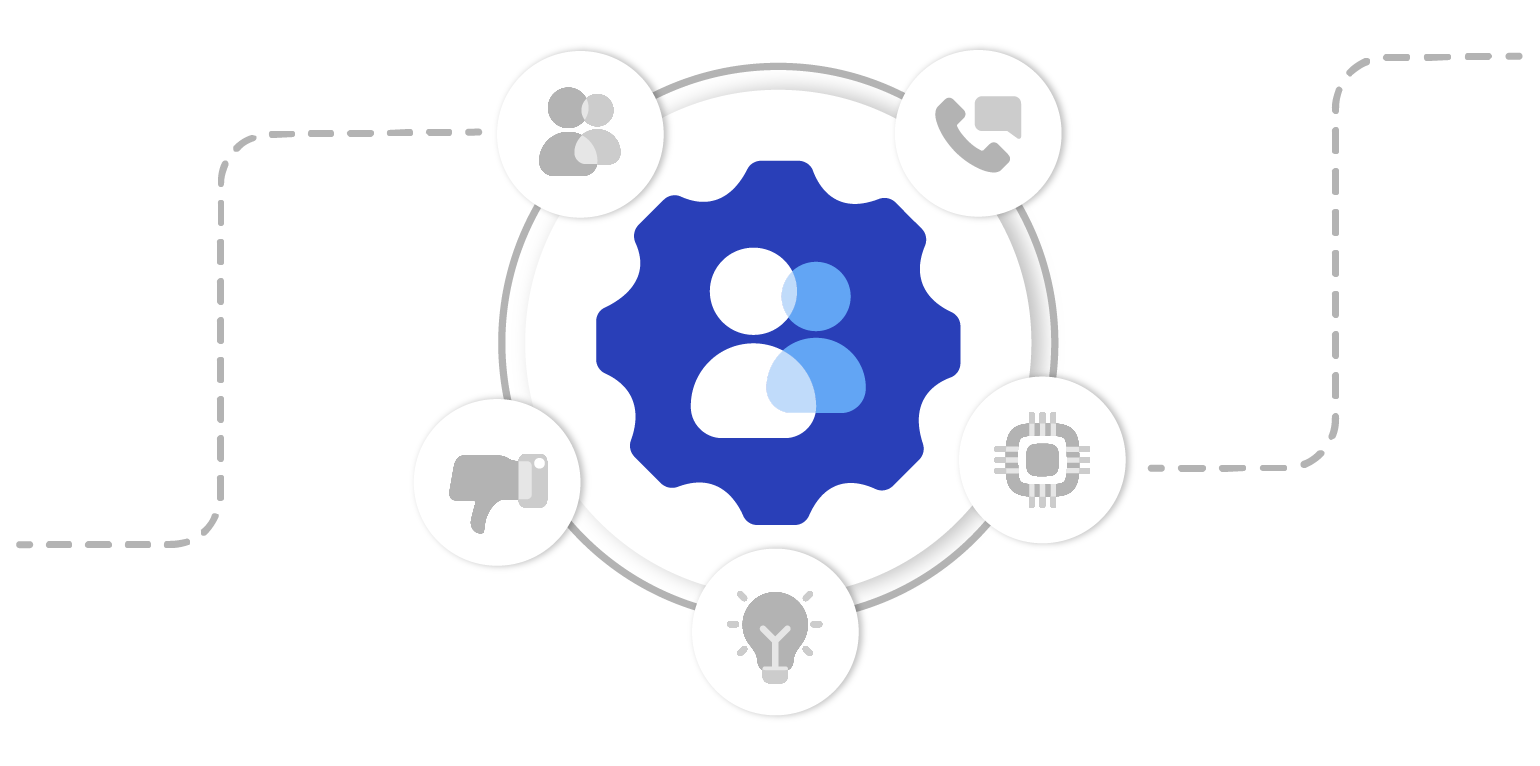Businesses are continually challenged to meet and exceed the ever-changing needs of their customers. As competition intensifies, so does the pressure to deliver superior service and unforgettable experiences.
One solution that stands out in the pursuit of customer service excellence is customer service automation (CSA).
What Is Customer Service Automation?
Customer service automation, or CSA, uses technology like artificial intelligence (AI) and machine learning (ML) to automate repetitive customer service processes.
By leveraging these advanced technologies, CSA introduces efficiency, speed, and accuracy into routine customer service tasks. As a result, customer service representatives have more time and energy to handle complex issues demanding a human touch, while customers receive faster and more accurate assistance.
How Customer Service Automation Works
Let’s illustrate customer service automation with a real-life scenario.
A customer lands on your e-commerce website to buy a product. They have a question about product specifications, so they initiate a chat. Instead of a human representative, an AI chatbot answers them, providing instant and accurate information.
Then if the customer places an order, they receive an automated email confirmation. Afterward, they receive updates about the status of their order via automated emails or text messages.
Simultaneously, on the company’s side, customer service automation keeps agents informed about the customer’s journey, automatically updating customer records, and sending follow-up reminders. If there’s a problem AI can’t solve, the system alerts a human representative, who steps in to help.
This seamless integration of technology and human effort makes customer service automation a game-changer for customer service.
How Customer Service Automation Influences Customer Experience
In today’s competitive business landscape, creating a customer experience that not only satisfies but also delights is crucial. Customer service automation (CSA) significantly influences this experience by capitalizing on three key elements: speed, convenience, and autonomy.
Speed
In an era where everything is instant, time is of the essence. Customers expect quick solutions and instant responses. Customer service automation fulfills this need with remarkable efficiency. It automates repetitive tasks, allowing customer service representatives to address more complex issues while quickly responding to customer queries.
By significantly reducing service time and providing immediate answers, CSA ensures customers don’t have to wait long. This speed of service enhances customer satisfaction, builds trust, and fosters loyalty.
Convenience
The customer is king, and convenience is their crown. Customers now demand service on their terms — at their preferred time and through their preferred channels.
Customer service automation rises to this challenge by offering 24/7 customer support, regardless of the location or time zone. Whether it’s a query in the middle of the night or a complaint early in the morning, CSA ensures there’s always help available.
This eliminates the constraints of traditional working hours, offering customers the convenience they want and deserve.
Autonomy
Modern customers like to have control and autonomy in their interactions with businesses. They prefer self-guided customer service that allows them to find solutions at their own pace. Customer service automation gives customers this sense of control through self-service portals, AI chatbots, and comprehensive online resources.
Self-service portals let customers manage their accounts, track orders or services, and access support without engaging with a service representative.
AI chatbots provide instant responses to common queries and can guide customers through simple processes or troubleshooting steps.
Online resources give customers information they can access anytime to get answers to their questions or learn more about the products or services.
By empowering customers to resolve basic issues independently, CSA fosters a sense of control among them, enhancing customer satisfaction, and reducing the load on the customer service team.
Examples of Customer Service Automation
As businesses evolve to meet the rising demand for superior customer service, customer service automation (CSA) has become an integral part of their strategy. CSA can take on various forms depending on your business’s specific needs and goals and the nature of your customer interactions.
Here’s a closer look at some common CSA tools and how they can transform your business.
AI Chatbots
AI chatbots, one of the most popular customer service automation tools, are programmed to mimic human conversation. They can instantly understand and answer customer inquiries, ensuring they receive immediate assistance.
By handling routine inquiries, chatbots free up customer service agents to focus on more complex tasks that require a human touch. This results in a more efficient use of resources and increased customer satisfaction.
Email Automation
Communicating efficiently with your customers is vital for building long-term relationships. Email automation systems can send order confirmations, updates, newsletters, and even personalized messages based on customer behaviors, all without human intervention. This ensures constant and consistent communication with your customers, making them feel valued and informed.
Knowledge Bases
Knowledge bases are like digital libraries that store extensive information about your products or services. These self-service hubs contain FAQs, guides, tutorials, and other resources that customers can access anytime. This empowers customers to solve basic queries on their own, increasing their autonomy and satisfaction.
Triggered Actions
Triggered actions, another significant aspect of customer service automation, are automated responses or actions set off by specific customer behaviors or events.
For instance, if a customer abandons their shopping cart, an automatic email reminder can be sent. These actions help your business respond to customer activities promptly and provide a more personalized and engaging service experience.
Interactive Voice Response (IVR)
IVR systems are automated telephony systems that interact with callers, collect information, and connect them to the appropriate agent. Using pre-recorded voice prompts and responses, they streamline the call-handling process by directing customers based on their needs. This reduces wait times and ensures customers reach the most capable agent for their specific issues.
CRM Process Automation
CRM process automation involves automating various customer relationship management tasks such as data entry, customer follow-ups, reminders, and even some sales and marketing activities. This automation reduces manual labor, eliminates the risk of human error, and enhances the overall efficiency and effectiveness of your customer service operations.
Customer Service Automation Benefits
A well-implemented customer service automation (CSA) system can benefit your organization and customers. Here’s how:
Service Cost Reduction
One of the most compelling benefits of customer service automation is the potential for significant cost reduction. By automating routine tasks and processes, CSA minimizes the need for manual labor and helps manage resources better.
As a result, businesses can get substantial savings, allowing them to enhance their service quality without the added burden of escalating costs.
Improved Speed and Efficiency
In customer service, customers value quick responses and resolutions. Customer service automation helps enhance operational speed and efficiency by accelerating response times and streamlining service processes.
Quick and efficient services not only meet customer expectations but also translate into customer satisfaction and loyalty, contributing to your overall business success.
24/7 Support Availability
Offering round-the-clock support can be a significant advantage to any business. With customer service automation, your business can provide support 24/7, meeting the demands of customers from different locations and time zones. This continuous availability of support can significantly boost customer satisfaction and foster loyalty.
Human Error Mitigation
Human errors, especially in repetitive tasks, can lead to service inconsistencies, customer dissatisfaction, and potential loss. Customer service automation eliminates these errors, ensuring high-quality, consistent service.
Elevated Customer Experience
Customer service automation can significantly improve the customer experience. By providing customers with instant access to support and information, CSA improves various aspects of the customer journey.
Furthermore, the ability to tailor interactions to customers’ preferences and needs fosters a personalized experience. This level of personalization can significantly enhance customer satisfaction and brand loyalty.
Promotes Team Collaboration
Customer service automation can also foster better team collaboration. By streamlining communication and providing a centralized platform for data sharing, CSA promotes efficient teamwork. Improved team coordination can further enhance service delivery, leading to better customer experiences.
Optimize Data and Analytics
Customer service automation can provide invaluable real-time data and insights, empowering businesses to make informed decisions, optimize operations, and stay competitive in a saturated market.
Enhanced Consistency
Consistency in customer interactions is crucial in building a strong brand image. Customer service automation ensures uniformity and reliability in customer interactions, leading to improved customer satisfaction and a competitive edge in the market.
Drawbacks of Customer Service Automation
Despite its numerous benefits, customer service automation is not without challenges. Businesses need to consider these drawbacks when planning their CSA strategy.
Lack of Human Touch
One of the downsides of automation is that it sometimes lacks the empathy and understanding a human agent can offer. To overcome this, businesses must balance automation with human interaction to provide a humanized and empathetic service experience when needed.
Customer Frustration
Automated systems can sometimes misunderstand complex customer queries, leading to frustration. To address this, businesses need to train and update their AI systems regularly. This way, the systems evolve and learn over time, becoming more capable of handling complex queries effectively.
Limited Problem-Solving Ability
Automated tools might struggle to resolve unique or complicated problems. To rectify this, businesses should have a seamless escalation process to human agents when necessary to ensure customers receive the help they need, even for complex issues.
Threat to Customer Service Jobs
Customer service automation might raise concerns about job security for customer service representatives. However, instead of replacing them, CSA should be used to upskill customer service agents so they can handle more challenging and fulfilling tasks and provide a higher level of service.
Too Much Technology Reliance
Relying too much on technology can be problematic, especially during technical glitches or outages. To ensure continuous service delivery, businesses should have a robust backup plan and the flexibility to switch to human support when necessary.
How to Automate Customer Service
Implementing customer service automation (CSA) strategically can translate into significant transformations in your customer service operations. It can lead to increased efficiency, cost savings, and, most importantly, customer satisfaction. Here’s a step-by-step guide on how to automate your customer service:
Identify the Areas of Need
The first step in adopting customer service automation is identifying the areas in your customer service process that consume significant time or face regular bottlenecks. Pinpoint tasks that are repetitive, mundane, or prone to human error.
Also, look for aspects of your operation where customer inquiries peak or delays could lead to dissatisfaction. These are typically where automation can bring the most value.
Select the Right Automation Tools
The market is full of various automation tools, each with different features and capabilities. It’s crucial to select the right tools that fit your business needs and can scale with you. Consider ease of use, integration capabilities, customization options, and the tool’s ability to grow and adapt to your business.
Define Automation Objectives
Before embarking on your CSA journey, clearly outline what you aim to achieve with automation. Are you looking to reduce costs? Enhance operational efficiency? Improve customer satisfaction? Or all of the above? Defining these objectives will guide your automation strategy and help measure its effectiveness.
Implement Gradually and Test
Transitioning to an automated system is a significant change that should be managed carefully. Instead of automating everything at once, start with one or two key areas. Test them, tweak them as needed, and evaluate their impact. This allows you to adjust and gauge user reaction before full implementation, reducing risks.
Train Your Team and Monitor
Ensure your team understands the new system and how to effectively use it. Provide training sessions and user manuals if needed. As automation takes over certain tasks, your team members can focus on more complex customer issues and personal interactions. Regularly review your automation process to improve it.
Get Feedback
Your customers and employees are the end users of your CSA systems, so their feedback is invaluable. Collect and analyze their feedback to refine your automation efforts and show them they’re valued.
When You Should Not Adopt Customer Service Automation
Despite its numerous benefits, customer service automation may not be suitable or necessary for every situation.
Customers with Sensitive Issues
In emotional or sensitive issues, human empathy and understanding are invaluable. These demand a human touch, which machines are not capable of replicating.
Highly Specialized Services
When offering highly specialized or industry-specific services, human agents remain indispensable. They can provide expert advice and handle complex issues that machines might not handle.
Initial Customer Contact
The first time a customer interacts with your business sets the tone for your relationship. Human interaction, be it a friendly welcome message or a personalized email, can feel more genuine and create a strong first impression.
Low-Volume Inquiries
For businesses that receive low customer inquiries, the cost and effort involved in implementing customer service automation may outweigh the benefits. In such cases, human-led customer service might be a better approach.
Transform Customer Service Efficiency & Effectiveness with Kizen
At Kizen, we offer advanced customer service automation that’s specifically engineered to streamline customer service processes — even those unique to your organization.
Our ability to deploy custom enterprise neural networks that are 100% unique to our client’s organization enables us to integrate your most valuable customer service technology and data.
We deploy faster than any other enterprise technology, which provides unprecedented time to value for our clients. This approach allows you to achieve noticeable improvements in customer service experience and efficiency within weeks, even for complex organizations.
If any of this sounds like what you’re seeking for your enterprise, and you’re interested in exploring today’s most powerful customer service automation technology — book some time with a Kizen expert to discuss your organization’s goals.
The Inevitable Shift to Automation
The digital era demands businesses to constantly evolve and adapt. Embracing customer service automation is no longer a choice but an inevitable step toward staying competitive.
As you consider taking this transformative journey, entrust your automation needs to Kizen and see the significant improvement in your customer service operations.
Contact us today, and let us help you modernize your operations, delight your customers, and drive your business growth.
Additional Resources
https://kizen.com/content/automation/business-process-automation/crm-automation/













